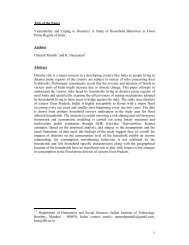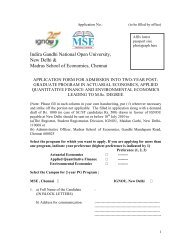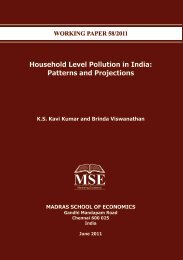A Macro-Fiscal Modeling Framework for Forecasting and Policy ...
A Macro-Fiscal Modeling Framework for Forecasting and Policy ...
A Macro-Fiscal Modeling Framework for Forecasting and Policy ...
Create successful ePaper yourself
Turn your PDF publications into a flip-book with our unique Google optimized e-Paper software.
have developed some useful tests <strong>for</strong> endogenously determining multiple structural<br />
breaks.<br />
2.4 Estimating the Timing of Structural Break<br />
In many applications the break date, i.e. timing of structural break may not be known by<br />
exogenous or a priori in<strong>for</strong>mation. In general, it may be best to infer the break date from<br />
data. One possibility is to use the largest value of the Chow test sequence. Qu<strong>and</strong>t<br />
(1960) infact proposed taking the largest Chow statistics over all possible break dates. 2<br />
Hansen et. al (2001) also discusses this <strong>and</strong> argues that this procedure may be reliable<br />
only when the Chow test is constructed with the homoskedastic <strong>for</strong>m of covariance<br />
statistics. Bai (1994, 1997a) derives the asymptotic distribution of the break date<br />
estimator <strong>and</strong> provides a method to construct a confidence interval around the break<br />
date <strong>for</strong> a single variable. Chong (1995) <strong>and</strong> Bai (1997b) describe methodologies <strong>for</strong><br />
estimating multiple structural break dates by using the sum of squared errors as a<br />
function of break dates, which have a local minima near each break date. The global<br />
minimum can be used as the break date estimator <strong>and</strong> other local minima can used as<br />
other c<strong>and</strong>idate estimators <strong>for</strong> multiple breaks. Bai, Lumsdaine <strong>and</strong> Stock (1998) extend<br />
the analysis to multiple time series with multiple break dates.<br />
After extensive testing, Bai <strong>and</strong> Perron (2003) contended that most<br />
macroeconomic time series are not characterized by the presence of a unit root <strong>and</strong> that<br />
fluctuations are indeed transitory. Looking at the U.S. data, they find that only two<br />
events had a permanent effect on the various macroeconomic variables: the Great Crash<br />
of 1929 <strong>and</strong> the oil price shock of 1973. Implicit in this analysis is their postulate that the<br />
Great Crash <strong>and</strong> the oil price shock were not a realization of the underlying data<br />
generating mechanism of the various series. Instead, these shocks are taken as<br />
exogenous. The exogeneity assumption time is used as a device to remove the influence<br />
of these shocks from the noise function.<br />
Some recent literature on multiple structural beaks includes Andrews, Lee <strong>and</strong><br />
Ploberger (1996), Garcia <strong>and</strong> Perron (1996), Liu, Wu <strong>and</strong> Zidek (1997), Lumsdaine <strong>and</strong><br />
2 Qu<strong>and</strong>t (1960) also considered that y t is subject to a one time change in mean at some unknown<br />
date T b , i.e., y t = 1 + 2 l (t>T b ) +e t where e t ~ iid (0, e 2 ) <strong>and</strong> l(.) denotes the indictor function.<br />
He also introduced the Sup F test (assuming normally distributed errors). It is basically a<br />
likelihood ratio test <strong>for</strong> a change in parameter evaluated at the break date that maximized the<br />
likelihood function (Perron, 2005).<br />
29



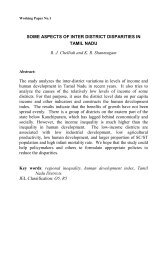
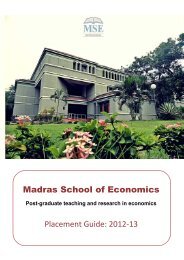
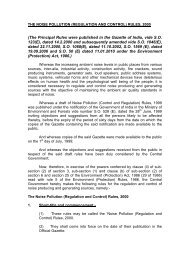
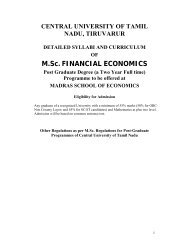
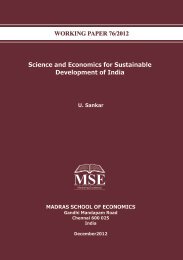
![Curriculum Vitae [pdf] - Madras School of Economics](https://img.yumpu.com/49878970/1/190x245/curriculum-vitae-pdf-madras-school-of-economics.jpg?quality=85)
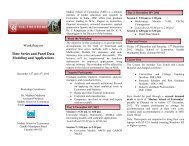
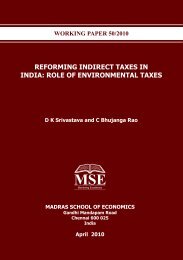
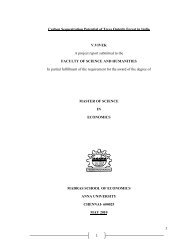
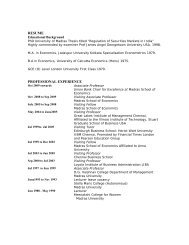
![Curriculum Vitae [pdf] - Madras School of Economics](https://img.yumpu.com/48715201/1/184x260/curriculum-vitae-pdf-madras-school-of-economics.jpg?quality=85)
